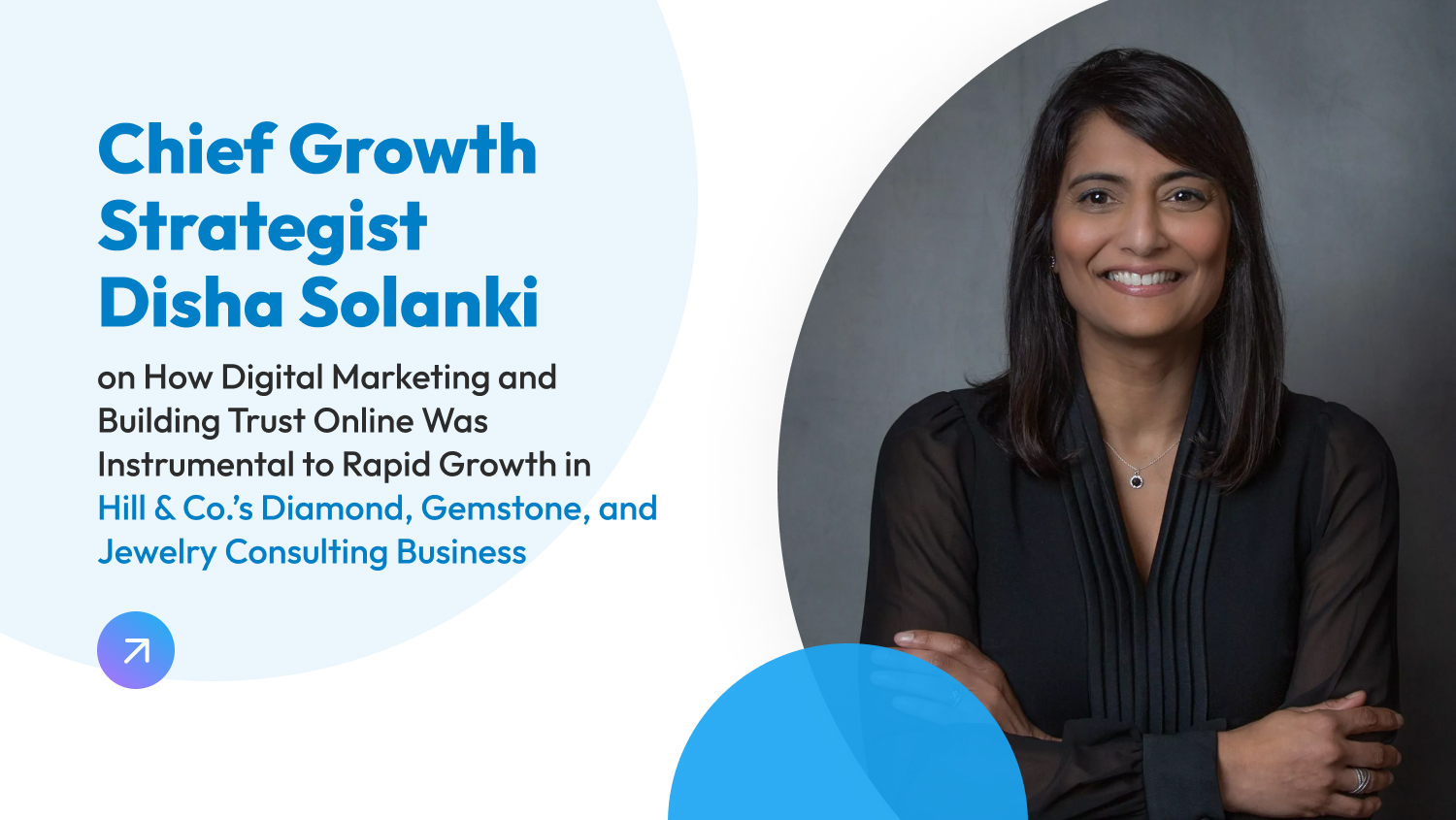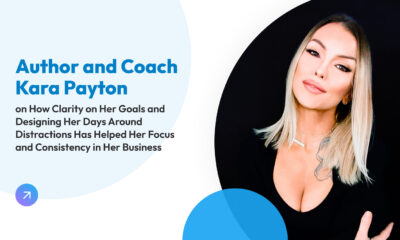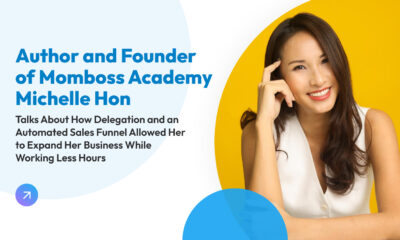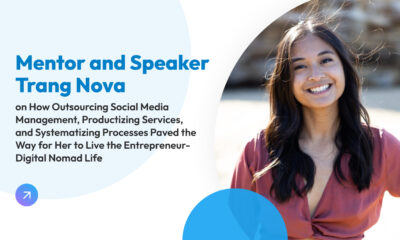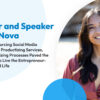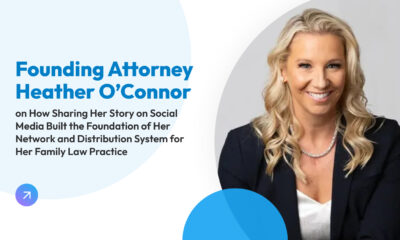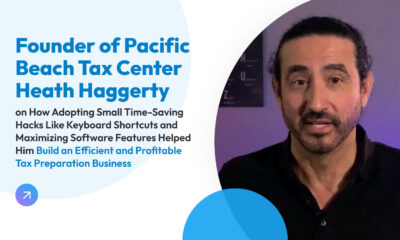Case Study
Chief Growth Strategist Disha Solanki on How Digital Marketing and Building Trust Online Was Instrumental to Rapid Growth in Hill & Co.’s Diamond, Gemstone, and Jewelry Consulting Business
Hill & Co. had an industry expert in its founder, Elle Hill, and access to many other top consultants in the diamond, gemstone, and jewelry supply chain. But when Hill set her sights on growing the business, she knew she needed another expert on the team.
Disha Solanki joined Hill & Co. as managing partner and Chief Growth Strategist, bringing her over 15 years of experience in launching, growing, and advising big and small enterprises on how to scale. What did it take to make Hill & Co. the successful global jewelry B2B consulting company it is today?
Solanki shared with us Hill & Co.’s story and the people, systems, and tools that helped them reach more clients and accelerate expansion. Don’t forget to check out the company’s Productivity Stack Quick Reference and Solanki’s Read-Listen List at the end of the article.
Table of Contents
- Starting
- Growing
- Scaling and Success
- Hindsight: What Solanki would have done earlier
- Advice from Solanki: People buy from people
- Wrap Up
- Solanki’s Read-Listen List
- Solanki’s Productivity Stack Quick Reference
- More About Disha Solanki
Starting
Challenge 1: Trying to do everything yourself
Solanki joined Hill & Co. about two years after its launch when the company didn’t have all of its systems, processes, and tools in place yet. Having built several businesses from the ground up, she wasn’t afraid to roll her sleeves up and get to work on the most basic tasks. She tried to do everything from setting up emails and meetings to figuring out document storage solutions, how to send proposals, and how to interact with clients.
“I would say the biggest challenge [in the beginning] is you try and do everything yourself when you are an owner and someone working in the business. In my case, I was trying to grow the business, but that still meant I was doing lots of things myself.”
At this point, the company was comprised of Hill, Solanki, and one other staff member who worked directly with Hill. As they got busier, things got messier.
Solution: Solanki started working on the SOPs and systems. Eventually, they hired an intern to assist with the workload, and, soon after, contractors to help with the technical and digital needs of the business. The contractors were hired for one-off tasks like website updates, setting up emails, and copywriting. This not only saved time for the founders but delegated jobs to people better qualified to do them.
People: Solanki, founder, one team member, intern, contractors
Systems: Documenting SOPs, outsourcing through an intern and contractors
Tools: LinkedIn, Job boards, Google Workspace, WordPress
Growing
Challenge 2: Building out their technology stack
Finding the right tools was equally important as laying out SOPs and hiring additional help. Among their first issues was file storage, especially for their process documents and high-resolution images. They also needed an upgrade to their project management tool – they were spending hours manually making Gantt charts on Powerpoint!
Solution: Solanki and the team tried several different options for storage, including iCloud, OneDrive, and Google Drive, before eventually settling on Dropbox. For project management, they switched over to monday.com, with plans to integrate this with their storage solution.
The process of building their tech stack happened over many years, and is still ongoing (see Challenge #5). Today, other tools in their tech stack include Google Workspace, Adobe, Xero for invoicing and WhatsApp for team communications. They have also signed up for the proposal software Proposify.
People: Solanki, founder, contractors
Systems: Testing various tools to find best fit
Tools: Dropbox, monday.com, WhatsApp, WordPress, Adobe Acrobat, Google Docs, Word, Google Workspace, Xero, Proposify
Challenge 3: Distribution and going online during COVID
Like many other businesses, COVID lockdowns forced Hill & Co. to evolve from doing things traditionally to going digital. Pre-pandemic, they relied on trade shows and other in-person events to network, promote the business, and meet with clients and prospects. Because of the pandemic, they had to figure out how to market themselves and how to connect with their clients virtually.
Solution: Solanki explains how important digital marketing has become for them. Even as a consulting company focusing mainly on businesses in the jewelry and gemstone supply chain, their website and social media have helped them reach a wider audience and find more leads.
Solanki explains, “You can’t underestimate how much people go online now, even B2B businesses. We service everyone from mine to market. So a lot of our businesses are [actually] B2B businesses, not B2C businesses. [We focus on companies that are involved in] how the diamond or gemstone is mined, manufactured, polished and how eventually it is designed to become part of a piece of jewelry.”
She elaborates how their online presence is crucial in building rapport with potential clients in the B2B space. “If you’re doing video, you’re doing social posts, if you’re writing in your own personality, all of these things make a difference. Because when people meet you for the first time in person, they already have a really good understanding of the person you are, and whether they’d like to do business with you already or not.”
This rapport with clients and prospects had to translate into productive meetings, and during the lockdowns, they had to find the best video conferencing platforms. They tried Google Meet and Microsoft Teams before finally choosing Zoom.
They were particularly concerned about automating note-taking during virtual meetings, and Solanki explains, “You don’t want to be looking down and [the client] doesn’t know what you’re doing because they can’t see what’s at the other end of the screen.”
They finally decided on using Zoom transcriptions, supplemented by human transcription services available through Rev. Their global clientele meant they spoke with a lot of people with different accents, which automated transcriptions couldn’t handle well. If clients use other video conferencing platforms, they use voice note recording on their mobile phones or video screen recordings.
Solanki credits their rapid growth in the last 18-24 months to this period of digital transformation. “The pivot during that time, I think, is a beneficial one. So now, we get the benefit of online and in-person, and it’s nice to have that mix.”
People: Solanki, founder, contractors
Systems: Focusing on B2B digital marketing, ensuring a seamless shift from in-person to virtual meetings
Tools: WordPress, LinkedIn, Instagram, Zoom with transcription, voice note app on mobile phone, video screen recording on a laptop
Scaling & Success
Challenge 4: Delegation: Building a team of full-time hires
As Hill & Co. got their systems in order and strengthened their online presence, their client list began to grow. In the earlier years, founder Elle Hill was the only in-house consultant, and they would contract external consultants as needed. But at this stage, they needed to have more experts within the team and full-time staff to handle the support functions.
Solution: From a team of three when Solanki first joined, Hill & Co. has grown to a team of ten. Solanki shares, “First, we hired experts that could help us service clients. We like to recruit anyone who is a true expert in their field and really passionate about what they do.”
Next, they hired a Chief Financial Officer and a Chief Marketing Officer. With the focus on their online presence, they’ve recruited a full-time CMO who can take charge of the website and work with a copywriter for content like case studies, and stay on top of all their digital marketing needs.
People: Solanki, founder, expert consultants, CFO, CMO, copywriter
Systems: Hiring full-time expert consultants to deliver their core service to a growing clientele, hiring full-time support staff for finance and marketing
Tools: LinkedIn, job boards
Challenge 5: Refining the tech stack
The company has adopted many tools over the years. Yet they can add more, like training software, CRM, and social media schedulers. Solanki tells us, “We’re probably not utilizing all the functionality of what we have, but we’re continuing to add. As we grow, it can actually get confusing for everybody on the team.”
Solution: They decided to hire a tech stack specialist to audit and streamline what they have. “We’ve come to a point where we have to just hone in what we have right now, and maybe we offload some of the tech stack that we’re using. And we would onboard different technology that may future-proof us a little bit more.”
Solanki and the newly hired tech specialist met for over six weeks before starting this project. One idea they’ve considered is to use Zapier to integrate the different tools.
People: Solanki, tech stack specialist
Systems: Reviewing and streamlining the tech stack, hiring a tech stack specialist
Tools: LinkedIn, job boards, Zoom
Challenge 6: Working with a fully remote team in different parts of the world
The Hill & Co. team started with a few individuals based in the UK but has now grown and transformed into an entirely virtual company with expert consultants and team members based in different parts of the world. The founders are in the UK, they have one consultant in France, and the majority of other team members are on the US east coast. What is it like working together across different time zones?
Solution: Solanki tells us how they coordinate work hours. “We do have the rule that we don’t expect anyone to work at a time when somebody else isn’t working. So we’re all very respectful of the time zones in which we are at the end of the day. And it works very well for us at the moment.”
They use WhatsApp a lot and have a weekly whole-company Monday meeting at a time that works for all. Any other smaller group meetings can be arranged among other members outside of that.
People: Whole company
Systems: Setting a policy of respect for non-work hours in different time zones, implementing flexible work schedules, maximizing technology for remote work
Tools: WhatsApp, Zoom, Adobe Acrobat, Google Docs, Word, Google Workspace
Challenge 7: Learning to be strategic about decision making
Solanki shares that she and founder Hill sometimes faced the challenge of rushing into situations or making decisions without taking time to study the wisest course of action.
“When you’re in the weeds, and you’re not looking over the mountain from a bird’s eye perspective, you forget that actually maybe a lot of these little bits you didn’t need to do. Your time would have been best spent elsewhere. You maybe could have gotten the right technology in to help, the right process. Or you could have just saved a lot of time and hassle if you had just taken half an hour before you began something to just plan it out.”
Solution: Solanki admits it is much easier to be strategic and take a holistic approach when analyzing client problems. The company ethos, after all, is ‘the client and service delivery always comes first.’ So she has decided that moving forward they will practice this same ethos and service level internally as well.
Solanki and Hill have learned over the years that they make better decisions when they take the time to strategize. “Making [decisions] off the cuff or from an emotional standpoint is easy to do when you’re in the trenches, and you’re feeling overwhelmed, and your to-do list is never-ending, which is always the case for an entrepreneur. But it’s learning how to manage that in your mind and to just stop and say, this is an important decision. Let’s reconvene as a team or as a human being.”
She now has a 24-hour rule about making any decisions, especially pertaining to those requests ‘you aren’t happy about.’ And she encourages consulting with each other on the team to help them collectively think through the best course of action.
People: Solanki, founder, the whole company
Systems: Apply the ‘client comes first’ ethos internally
Challenge 8: Time management: Getting more focused and effective
When we asked about her time management strategies, Solanki confessed that she used to ‘sporadically do tasks.’ “I think as entrepreneurs, we jump from one thing to the next really quickly. It’s like, ‘What’s the next shiny thing I can work on?’ But all the jobs or tasks we procrastinate over, we still procrastinate over.”
Solution: Solanki set time blocks at the start of the day to focus specifically on the big tasks she kept delaying. “I [set them] at the beginning of the day, not at the end of the day, because I was finding I was chasing my tail. I’d put it off, put it off, and put it off. Then about nine o’clock at night, I [think], ‘I really should get to those tasks I didn’t get to today.’ I find it very frustrating when I don’t complete a task. You don’t get that sense of achievement.”
Now, Solanki has made a commitment to close out her big to-do’s earlier in the day so she can make space for new initiatives. She uses another simple hack of setting phone alerts to stay on track with the schedule.
People: Solanki
Systems: Time blocking, Eat the Frog strategy
Tools: Google Calendar, mobile phone
Hindsight: What Solanki would have done earlier
Solanki points out that setting up systems that weren’t in place when she joined is something she would have prioritized. Not only would this have made growth easier, but she also describes how difficult it is to reverse engineer their processes. “Unraveling things that could have been done right in the first place is really painful, really tedious. And it involves people with a certain skill set that can unravel, go into detail, and figure out what belongs in what standard operating procedures. It’s easier to do that as you’re going along the journey than it is to do it when you’re at the other end. It feels like you’re trying to reinvent the wheel.”
Advice from Solanki: People buy from people
Solanki explained why she thinks their digital marketing strategy has been so successful in bringing them new leads.
“People buy from people inevitably. That’s why it’s important that everybody knows who the people are in our business and what their expertise is. [That includes] being on social media, doing videos, and even if some people are not comfortable with videos, encouraging them to let us showcase their personality in the written form, which really shows them off as humans. So any good achievements that our team would like us to share, we will share with our community. We are dealing with other people’s businesses, and it’s important that we’ve evoked that trust and expertise. And that’s online at the moment, we can’t get away from that.”
Wrap Up
Hill & Co.’s success with its digital transformation and online presence highlights the importance of synergy between technology, tools, and systems and the people behind them. While dedicating time to building a tech stack and getting SOPs in order was necessary to strengthen the business on the backend, it was how they showcased the team, their values, and their personality that brought them closer to their target market and helped them get more clients in the B2B jewelry consulting space.
Solanki highlighted a very people- and team-oriented culture in the company as well. We see this in their policy that everyone works during business hours in their respective time zones and how they celebrate everyone on the team as individuals with their personal achievements. This helps create trust within the company and also helps build that rapport and trust with potential clients who interact with their social media and other online marketing channels.
Solanki’s insight about ‘Hill & Co. comes first’ is their latest initiative, which emphasizes how they will also exercise the same devotion of time and strategic thinking when it comes to solving business issues or making decisions internally. Sometimes being reactive and rushing into decisions doesn’t help with overwhelm and this new motto is a great reminder to treat themselves as business owners and team members as important ‘internal clients’ of the company as well.
Solanki’s Read-Listen List
- The E-Myth Revisited: Why Most Small Businesses Don’t Work and What to Do About It book by Michael E. Gerber is a good place to start learning about how to standardize things within a business.
- Rocket Fuel: The One Essential Combination That Will Get You More of What You Want from Your Business by Gino Wickman and Mark C. Winters is like a beginner’s guide on how to scale.
- Brene Brown podcasts help her understand people and teams better, whether they be clients or their own staff. They help her deal with and appreciate the diversity of clients and team members.
Solanki’s Productivity Stack Quick Reference
Starting
- Job boards
- Google Workspace
- WordPress
Growing
- Dropbox
- monday.com
- WordPress
- Adobe Acrobat
- Google Docs
- Word
- Google Workspace
- Xero
- Proposify
- Zoom with transcription
- Voice Note app on phone
- Video screen recording on laptop
Scaling & Success
- Job boards
- Zoom
- Adobe Acrobat
- Google Docs
- Word
- Google Workspace
- Google Calendar
- Mobile phone
More About Disha Solanki
Disha Solanki is a multi-passionate visionary entrepreneur, Chief Growth Strategist, and Partner at Hill & Co, a Global Business Management Consulting firm specializing in the diamond, gemstone, and jewelry industry.
Through her 18 years of experience in strategy and business transformation, she has helped 50+ businesses to restructure, get clear on their audience, confidently increase their prices, and scale their businesses to seven figures and beyond.
Her mission is to empower women to grow and scale their already vast businesses using the right strategy, guidance, and support.
Learn more about Hill & Co. through their:
Website: http://www.hillandco.co
LinkedIn: https://www.linkedin.com/company/hill-&-co.-consulting/
Instagram: https://www.instagram.com/hill.and.co/
Or get in touch with Disha through LinkedIn: https://www.linkedin.com/in/dishasolanki/


